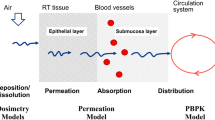Abstract
Significant arterio-venous differences in nicotine concentrations have been observed during and after cigarette smoking, nicotine nasal spray, and intravenous nicotine administration. In this paper we describe a novel mathematical method for estimating arterial blood levels from venous blood level data. The model allows to quantify: (i) the influence of the microcirculation in the hands and forearm on the distribution of nicotine, and (ii) the influence of disregarding the venous to arterial circulation in the estimate of systemic inputs. We also (iii) propose a general method to predict arterial concentrations and inputs given venous data. The basic model we adopt is based on the relationship Cv = T * Ca, where Cv and Ca are the concentration in the venous and arterial site, respectively, T is the arterio-venous transfer function and * indicates convolution. We use empirical data to estimate T. We then compare estimates of systemic inputs to the venous site obtained taking into account the transfer function or, as usually done, disregarding it. The relationship we use to compare estimated inputs are: Cv = T * ka * A (where Ka is the arterial disposition function and A the systemic input), and Cv = Kv * A (where Kv is the venous disposition function), respectively. Finally, the estimated transfer function allows to estimate (average) Ca or A given arbitrary venous data. (i) Our analysis suggests that a bi-exponential T is needed to describe observed arterial–venous differences. The estimated transfer function indicates that no elimination of nicotine is involved in the forearm. (ii) Disregarding T, as usually done, erroneously obtains too complex venous input functions (because these input functions incorporate T). (iii) Disregarding T erroneously estimates significantly higher total inputs. (iv) Using the proposed model and previously published venous nicotine level data we predict substantial arterial–venous differences in blood nicotine levels for smokeless tobacco and nicotine gum. The use of disposition functions obtained from venous data may lead to erroneous estimation of the rates of entry into the circulation and systemic bioavailability for many drugs.
Similar content being viewed by others
REFERENCES
D. Verotta, S. Beal, and L. B. Sheiner. Semiparametric approach to pharmacokinetic-pharmacodynamic data. Am. J. Physiol. 256:R1005–R1010 (1989).
W. L. Chiou. The phenomenon and rationale of marked dependence of drug concentration on blood sampling site: implications in pharmacokinetics, pharmacodynamics, toxicology, and therapeutics [part I]. Clin. Pharmacokin. 17:175–199 (1989).
W. L. Chiou. The phenomenon and rationale of marked dependence of drug concentration on blood sampling site: implications in pharmacokinetics, pharmacodynamics, toxicology, and therapeutics [part II]. Clin. Pharmacokin. 17:275–290 (1989).
B. Tuk, V. M. M. Herben, J. W. Mandema, and M. Danhof. Relevance of arteriovenous concentration differences in pharmacokinetic-pharmacodynamic modeling of midazolam. J. Pharmacol. Exp. Ther. 284:202–207 (1998).
S. G. Gourlay and N. L. Benowitz. Arteriovenous differences in plasma concentration of nicotine and catecholamines and related cardiovascular effects after smoking, nicotine nasal spray, and intravenous nicotine. Clin. Pharmacol. Therapeut. 62:453–463 (1997).
J. E. Henningfield, J. M. Stapleton, N. L. Benowitz, R. F. Grayson, and E. D. London. Higher levels of nicotine in arterial than in venous blood after cigarette smoking. Drug and Alcohol Dependence 33:23–29 (1993).
N. L. Benowitz, H, Porchet, L. Sheiner, and J. Peyton. Nicotine absorption and cardiovascular effects with smokeless tobacco use: comparison with cigarettes and nicotine gum. Clin. Pharmacol. Therapeut. 44:23–28 (1988).
H. C. Porchet, N. L. Benowitz, L. B. Sheiner, and J. R. Copeland. Apparent tolerance to the acute effect of nicotine results in part from distribution kinetics. J. Clin. Inûest. 80:1466–1471 (1987).
K. O. Fagerstrom. Measuring degree of physical dependence to tobacco smoke with reference to individualization of treatment. Addic. Behaû. 3:235–241 (1978).
P. Jacob, L. Yu, M. Wilson, and N. L. Benowitz. Selected ion monitoring method for determination of nicotine, cotinine and deuterium-labeled analogs-absence of an isotope effect in the clearance of (s)-nicotine-3´,3´-d2 in humans. Biol. Mass Spectro. 20:247–252 (1991).
N. L. Benowitz, K. Chan, C. P. Denaro, and P. Jacob, III. Stable isotope method for studying transdermal drug absorption: the nicotine patch. Clin. Pharmacol. Therapeut. 50:286–293 (1991).
D. Verotta. Concepts, properties, and applications of linear systems to describe the distribution, identify input, and control endogenous substances and drugs in biological systems. Crit. Reû. Bioeng. 24:73–139 (1996).
E. J. Hannan. Rational transfer function approximation. Statist. Sci. 2:1029–1054 (1987).
H. Akaike. A new look at the statistical model identification problem. IEEE Trans. Automat. Contr. 19:716–723 (1974).
S. L. Beal and L. B. Sheiner. NONMEM Users Guide, Part VII: Conditional Estimation Methods, Division of Clinical Pharmacology, University of California at San Francisco, 1992.
K. E. Fattinger and D. Verotta. A non-parametric subject-specific population method for deconvolution. II. External validation. J. Pharmacokin. Biopharm. 23:611–634 (1996).
D. Verotta. Drug Dynamics Modeling (DDM), A Nonparametric Approach.V1.0, User Guide, Technical Report, School of Pharmacy, University of California at San Francisco, 1999, in preparation.
S-PLUS, Statistical Science Inc. Seattle, WA, 1991.
D. Verotta. An inequality-constrained least-squares deconvolution method. J. Pharmacokin. Biopharm. 17:269–289 (1989).
Author information
Authors and Affiliations
Corresponding author
Rights and permissions
About this article
Cite this article
Pitsiu, M., Gries, JM., Benowitz, N. et al. Modeling Nicotine Arterial–Venous Differences to Predict Arterial Concentrations and Input Based on Venous Measurements: Application to Smokeless Tobacco and Nicotine Gum. J Pharmacokinet Pharmacodyn 29, 383–402 (2002). https://doi.org/10.1023/A:1020957208071
Issue Date:
DOI: https://doi.org/10.1023/A:1020957208071




